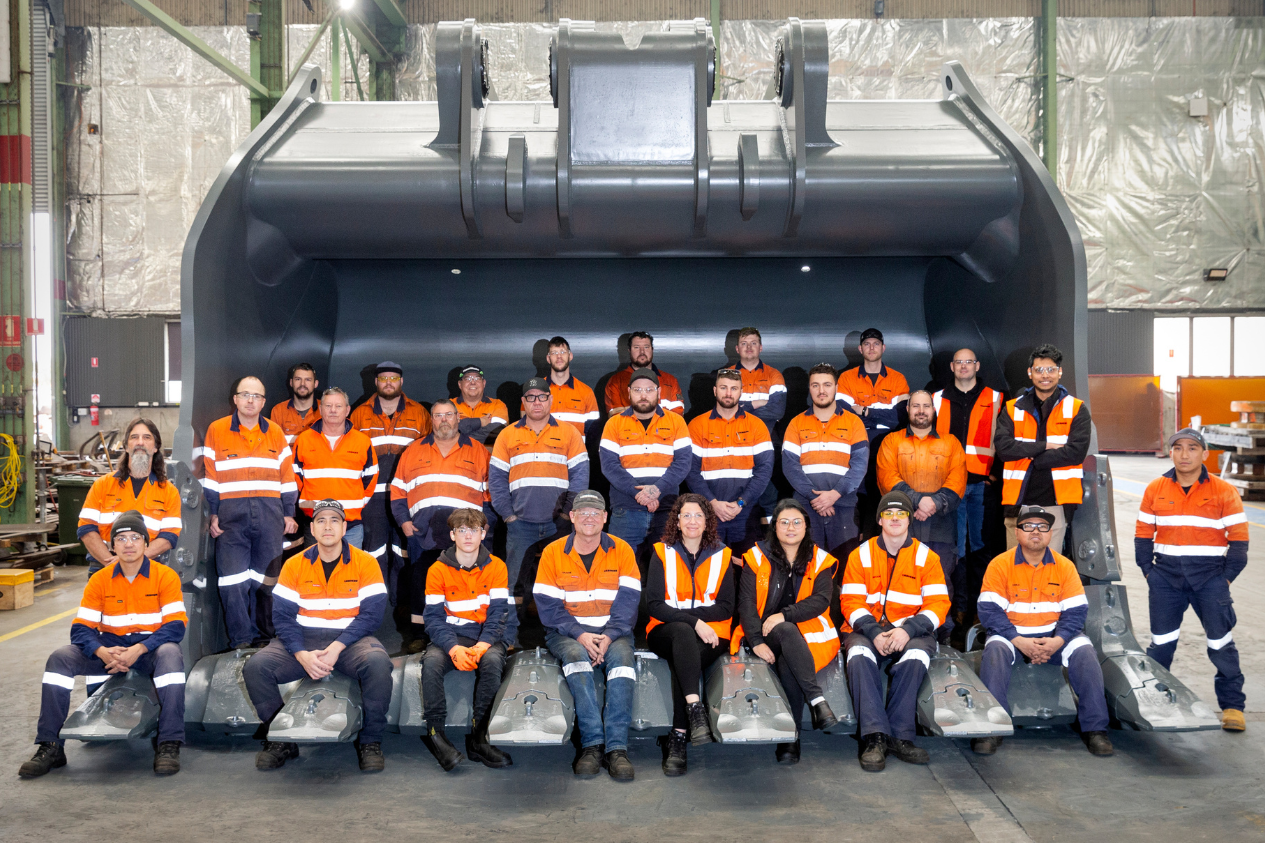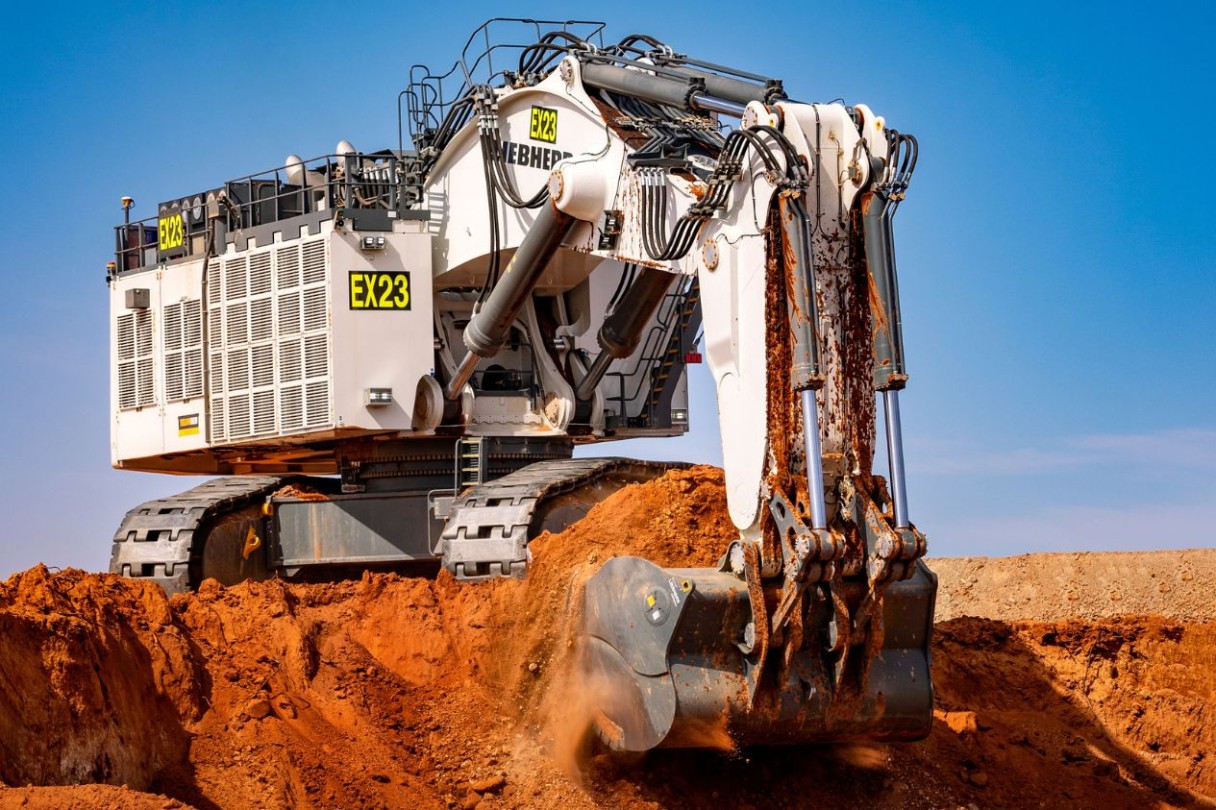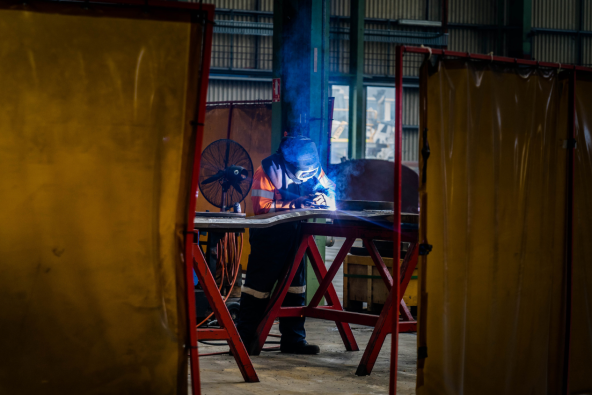
Conquering new challenges
In late 2023, Liebherr-Australia’s fabrication team in Adelaide was given a challenge. Yellow Iron Fleet, needed an R 9800 to work for a mineral sands application – a new commodity for Liebherr in Australia. Through hard work, collaboration and ingenuity Liebherr-Australia found the perfect solution for it's new customer.
The journey began in mid-2022 when the sales team at Liebherr-Australia Pty. Ltd (Liebherr-Australia) began working closely with Yellow Iron Fleet to find the best possible solution for its needs. Yellow Iron Fleet was due to commence its 10-year mining service contract with the Atlas Campaspe mineral sands mine in central New South Wales. The customer needed a machine that could support them in meeting onsite production targets and – after discussing this opportunity in detail – an R 9800 excavator with a customised bucket was determined to be the optimal fit.
'This R 9800 represents a lot of exciting milestones for us,' says Daniel Simone, key account manager, Liebherr-Australia. 'The delivery of this machine signifies the beginning of an exciting relationship with our new customer and a diversification of Liebherr-Australia’s commodity portfolio. This is the first time a Liebherr machine will be working in an Australian mineral sands application. Tronox – owner of the Atlas Campaspe mine and one of the key players in the mineral sands market – are now experiencing, first hand, both Liebherr's product and customer support capabilities.'
This is the first time a Liebherr machine will be working in an Australian mineral sands application. Tronox – owner of the Atlas Campaspe mine and one of the key players in the mineral sands market – are now experiencing, first hand, both Liebherr's product and customer support capabilities.
While the R 9800’s reputation as a powerful and reliable loading solution played a major part in Yellow Iron Fleet’s decision to acquire this excavator, it was Liebherr’s willingness to listen and adapt its machine to Yellow Iron Fleet’s needs that made all the difference.
'When we ordered the R 9800, we did have some concerns about the bucket not being properly suited to our application at hand,' says Andy Hoare, chief executive officer, Yellow Iron Fleet. 'However, after we explained our situation to Liebherr, the team was on board to work with us to find a solution.'
International collaboration
In Australia, the R 9800 excavator is usually seen in hard rock applications or in open-cut coal projects needing high volumes of overburden removed. However, Yellow Iron Fleet’s R 9800 will be working in mineral sands, a commodity usually found in coarse or fine grain sand that, generally, has a lower, loose specific gravity than the material the enormous excavator usually moves. As such, the excavator’s standard bucket needed to be adapted to accommodate the unique characteristics of this material. Undertaking this project required a combination of Liebherr-Australia’s manufacturing process; the excavator expertise of Liebherr-Mining Equipment Colmar SAS, Liebherr’s excavator factory in Colmar, France; and Yellow Iron Fleet’s knowledge of Atlas Campaspe and its geological makeup.
'The Liebherr-Australia and Colmar teams relied on data from Yellow Iron Fleet about their client’s unique operation to support the design, engineering and manufacturing processes for the bucket,' explains Simone. 'This is what enabled Liebherr-Australia’s fabrication team to deliver a tailored solution to the customer.'
What are mineral sands?
Mineral sands contain a number of invaluable minerals that are processed to become important commodities such as titanium, zircon and rare earth elements. Titanium is primarily used to produce titanium dioxide – a white pigment used during the production of paint, plastics and toothpaste. Zircon is used in the ceramics market to create things like kitchen benches and bathroom fittings. Rare earth elements – the name given to a group of around 17 elements – are crucial for a number of the technologies needed for a decarbonised future.
Because of the strength of the collaboration between Liebherr-Australia, the Colmar factory and Yellow Iron Fleet, finalising the adapted bucket design only took two weeks – despite being on two different continents.
'The support provided by the Colmar team was key to the successful delivery of this customised solution for Yellow Iron Fleet. Their knowledge, experience and detailed level of support empowered our sales team to assist our customer in conceptualising a tailored bucket for the application at hand,' says Simone. 'The Colmar team was prompt and concise with their support. This, coupled with our existing, robust bucket request process, enabled design and manufacturing to progress freely.'
In those two weeks, Liebherr-Australia, Liebherr-Mining Equipment Colmar SAS and Yellow Iron Fleet found a way to safely integrate the bucket into the R 9800’s frame and meet all ISO standards and fabrication tolerances.
‘I found our experience with Liebherr to be extremely positive, with the OEM [original equipment manufacturer] demonstrating a strong commitment to showcasing the power of collaboration and innovation,’ says Hoare. ‘I appreciated Liebherr’s out-of-the-box thinking, similar to our own entrepreneurial approach to business.’

Leveraging local expertise
Liebherr-Australia’s Adelaide fabrication workshop makes buckets for the Australian market, with customers spanning from the east coast to the west coast. The Adelaide team are well-versed in creating buckets for a vast range of applications and so manufacturing this customised bucket for Yellow Iron Fleet was no issue for the experienced group.
I’m incredibly proud of the work our team did to complete this unique bucket for Yellow Iron Fleet
Boilermakers, welders, machinists, riggers and trade assistants transformed the theoretical design into a tangible product while planners, coordinators, team leaders and the group leader helped ensure that the project stayed on track and that everyone had exactly what they needed, when they needed it. Different team members came on board at different stages, depending on their skillset.
In the end, building this tailored bucket for Yellow Iron Fleet took 20 people, 2,000 hours and 975 kilograms of welding wire.
‘I’m incredibly proud of the work our team did to complete this unique bucket for Yellow Iron Fleet,’ says Steve Smith, fabrication manager, Liebherr-Australia, Adelaide. ‘This project truly shows what our Adelaide facility, and the hard-working people within it, are capable of.’
Beyond the machine
Liebherr not only prides itself on providing exceptional equipment to its customers, but also on providing those same customers with exceptional customer service, wherever they are. The Atlas Campaspe site is approximately 12 hours away from its closest Liebherr-Australia branch, Mount Thorley in the Hunter Valley. This means that responding to unplanned downtime events could be tricky. To overcome this, Mount Thorley’s field service technicians visit the site fortnightly for service days and provide ad hoc labour when required. Yellow Iron Fleet also worked with closely with Mount Thorley’s customer support team to decide which critical spares the company needed to keep on hand at Atlas Campaspe so straightforward repairs could be completed by personnel already on site.
How to mine mineral sands
There are two ways mineral sands can be excavated: dry and wet mining. Dry mining uses conventional mining equipment like dozers, off-highway trucks and excavators to unearth the mineral sands. Wet mining, on the other hand, extracts the material from under a pond created specifically for mining purposes. Atlas Campaspe mine uses the dry mining technique.

'Collaboration is the cornerstone of progress and together we can achieve remarkable things' - Andy Hoare, chief executive officer, Yellow Iron Fleet
‘Liebherr’s customer service for this machine has been very good. Due to the unit’s distance from mining support facilities in the Hunter Valley, additional planning and thought has been required to accommodate the tyranny of distance. We have been impressed with the urgency placed on the deployment of parts and service on the few occasions when unplanned downtime has occurred,’ says Hoare.
The success of this project has laid a fantastic foundation for cooperation between Liebherr-Australia and Yellow Iron Fleet for the future.
‘We are dedicated to providing ongoing support for this machine and we are definitely looking forward to fostering this new partnership and seeing what other interesting opportunities might arise with Yellow Iron Fleet in the future,’ says Simone.
The extraordinary performance of this R 9800 has led Yellow Iron Fleet to order two R 9600s for their operations in Queensland. Delivery of these machines is scheduled for 2025. ‘I am very excited about the future,’ says Hoare. ‘We are looking at some long-term projects on the east coast of Australia that will present further opportunities to work more closely with Liebherr. Collaboration is the cornerstone of progress and together we can achieve remarkable things.’
Mineral sands in Australia
Australia has the largest mineral sands deposits in the world and is therefore a major player within the sector. In fact, Australia is home to a significant percentage of the world’s titanium-rich mineral sands. According to the Mineral Council of Australia’s 2020 ‘Mineral sands’ report, Australia holds 32 % of ilmenite reserves and 62 % of rutile reserves – both of which are important titanium ores and sources for titanium dioxide. As such, it is not surprising that the biggest market within the Australian mineral sands sector is domestic titanium dioxide producers. Tronox, owner of the Atlas Campaspe mine, is one of the biggest titanium dioxide producers in Australia.
